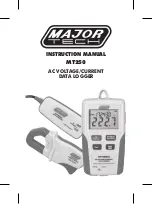
PicoLog Self-Help Guide
AR346-1
© Copyright 2014 Pico Technology Ltd.
14/34
On the server:
1. Start PicoLog
2. From the File menu, select Preferences
3. Select IP Sockets
4. Check the Enable Server box
5. Click OK
6. Set up PicoLog to measure the channels that you require
On the client:
1. Start PicoLog
2. From the File menu, select Preferences
3. Select IP Sockets
4. Check the Enable Client box
5. Exit and restart PicoLog
6. Select New Settings
7. Enter recording details and click OK
8. Enter the sampling details and click OK
9. Select Socket in the Converter Type combo box
10. Click OK
11. Type the server name, e.g. fred
Note: Server names are case-sensitive! Fred is not the same as fred
12. Click Connect
13. The computer should now display the channels from the server
14. Click on one of the channels
15. If you want to change the name, type in the local name
16. Click OK
17. The channel you selected is marked with an X
18. Repeat for each of the channels
19. Click OK
20. The monitor window should now display the readings from the server
13.
PicoLog file size and recovery
The largest file that is can be generated by PicoLog contains about one million samples
per channel (whatever the number of channels). If you wish to log for longer periods you
need to set PicoLog to Repeat Immediately at the end of a run. A new file will be started
with an auto-incremented file name. For ease of use, do not use the maximum file size,
but choose a convenient number of samples that gives a reasonable logging time per
file.
Once a file is saved to the hard drive it is safe from a PC crash or power loss. A long file
that is interrupted before saving can be corrupted and unreadable. We can sometimes
recover corrupted .plw files but only if you also have a good file available as well with
exactly the same settings to allow us to clone the headers across. Even a settings (.pls)
file with no actual data will work as well, as long as the channels, sample rate and
number of samples, etc. are identical.















































